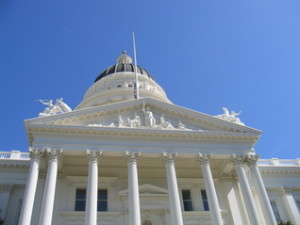It’s that time again – the beginning of state budget season. But unlike past years, the 2023-2024 budget is in a far more precarious situation. The last two budgets enjoyed massive surpluses and allocated billions of new dollars for clean transportation and climate programs. This year, however, California is facing a significant budget deficit – potentially up to $22.5 billion or more. This drastic turn in state revenues means less money for all state programs. And unfortunately as a result, the Governor has proposed to cut clean transportation and climate programs by $3.1 billion.
What does this mean for climate and clean transportation programs?
Needless to say, a $3.1 billion cut is a significant amount of money. The biggest cuts in the proposed budget affect incentives for clean trucks and off-road equipment, transit improvements and mobility programs. For example, the budget proposes to cut clean truck incentives by $1.5 billion, with other revenue sources backfilling part of the cut. Meanwhile, the Governor has proposed to cut allocations to the Transit and Intercity Rail Program, which funds vital capital improvements for the state’s transit system, by half. Should budget conditions improve, the budget only proposes to restore part of the program’s funding.
The Governor acknowledges his proposed cuts primarily affect climate investments. Given that recent budgets provided historic amounts of climate funding, the Governor argues it was one of the areas he could cut. The last two state budgets did allocate billions of dollars into climate programs. This included a multi-year agreement to invest $10 billion in zero-emissions vehicles. The Governor also argues that, despite the cuts, 89% of the state’s climate investments are intact. This funding agreement, however, stretched climate funding over five years. All the proposed cuts will happen in the 2023-2024 and, likely, the 2024-2025 budget years. The proposed cuts will have a deeper impact in the short term than just 11%. Further, there is no guarantee California will be able to honor the funding agreement in the future. Lastly, the amounts of climate investments needed far outstrip what California has provided, even with last year’s historic budget agreement.
How did we get here?
Despite its reputation for late, dysfunctional budgets and enormous deficits, California’s fiscal affairs have largely been in order since voters approved several reforms a decade ago. The state budget, however, continues to have a significant vulnerability: its heavy reliance on capital gains taxes. Essentially, a significant part of California’s tax revenues is tied to how stock markets and other investments perform. In times when stocks and investments perform well, tax revenues are flush. When stock and investment values fall, tax revenues dry up. And for much of 2022, stock market and investment revenues fell significantly.
Funding for our climate and clean transportation programs depends on four sources. These sources are:
- The state general fund (funded by tax revenues),
- The Greenhouse Gas Reduction Fund, or GGRF (funded by revenues from the state’s cap-and-trade program for greenhouse gas emissions),
- Various special state and local funds (funded by fees, special taxes and other revenue sources), and
- Federal grants.
Prior to 2020, state budgets relied mostly on GGRF funds for climate investments. Due to the strong performance of investments in 2020 and 2021, however, the bulk of the state’s climate money instead came from the more volatile general fund. Now, the state general fund has less money flowing into it. As a result, less money can flow out of it. Yet, the pressures and demands on the state budget have only grown, both in terms of climate and other needs. The ups and downs of state funding prompted an environmental/labor/business alliance to put Proposition 30, the Clean Air Initiative, on last year’s ballot, to provide sustained and robust funding for clean transportation and wildfire control through a progressive tax. Unfortunately, the measure was defeated by greedy billionaires and their allies.
Is there a silver lining?
Despite the difficult budget news, it’s important to remember a few things. First, it’s still early in the budget season. Revenue projections can change, and the legislature is still forming their priorities. Already, state legislators and advocates have expressed concerns about the cuts to climate and clean transportation. Additionally, there are other important state budget developments happening. The state must be able to take advantage of the unprecedented amounts of new federal funding. Further, the legislature needs to reauthorize Assembly Bill 118 (AB 118), which helps fund several clean transportation programs. State revenues will be clearer after the Governor’s revised budget proposal in May and the final cap-and-trade auction results for the fiscal year in August. Still, it’s safe to assume that new, massive investments in clean transportation are not happening this year. Rather, barring improving budget conditions and persistent advocacy, climate investments are on the chopping block.
What can you do to protect clean transportation?
You can help protect clean transportation funding! You can ask the Governor and your State Legislators maintain funding for clean transportation and climate programs. The next hearing of the Assembly Budget Committee focused on clean transportation will be on March 8 at 9:30 a.m. Ahead of the hearing, use social media to demand California #investincleanair and not cut climate programs. You can also provide written comments to legislative budget committees at asmBudget@asm.ca.gov and SBUD.Committee@senate.ca.gov. You don’t have to be an expert on air quality; your elected officials just need to know you care about the issue. To learn more about our efforts and how we’re trying to protect climate and transportation programs, visit https://www.investincleanair.com/ or follow @chargeaheadca on Twitter.
We have a lot of work ahead if all Californians are going to have clean, breathable air. Let’s get to it!








